World Ends… Again
rx does R.E.M.:
The End by Sluggomatic (8th place entry in Breaking News 5):
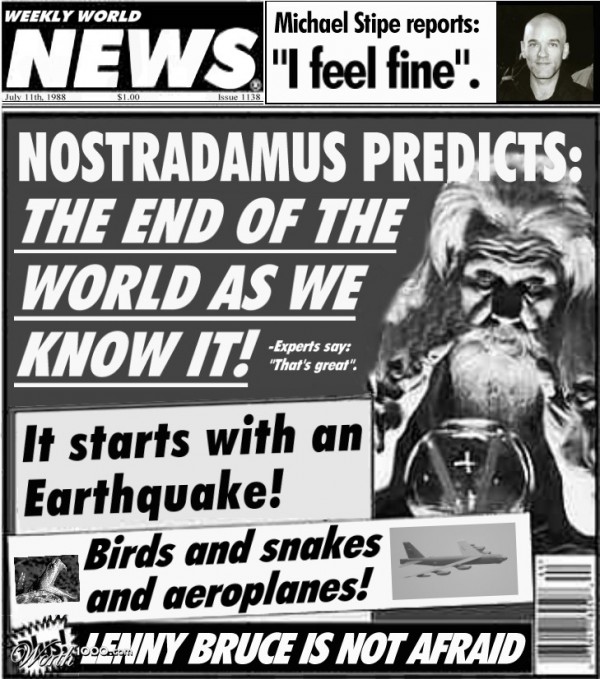
rx does R.E.M.:
The End by Sluggomatic (8th place entry in Breaking News 5):

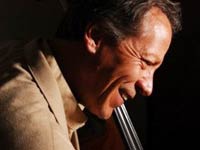 Jazz Bass- Kelly Roberti (1:21 mp3):
Jazz Bass- Kelly Roberti (1:21 mp3):
“The first time I heard Charley Parker I thought heard Be-Bop, like Charlie Parker with Miles Davis, it killed me. It was like: What is this chemical stuff?”
Our weekly hour series, Hearing Voices from NPR, has come to its end of days.
Many of the 150 outstanding HV hours will live on in the PRX archives.
Many thanks:
We’ve had a blast assembling the work of indies and NPR into these “sixty-minute streams of driveway moments.” We’re proud of our Peabody and other awards. We’ve loved the thousands of emails and site comments listeners have sent us. But all good things…
So, to you, our site visitors: Thanks for helping propagate outrageous radio.
Website owners often go WordPress plugin crazy. Plugins do so much, so quickly, so easily — from adding image galleries to keeping your site more secure. But plugins can cause WordPress woes: different plugs may not play well together, or, when not updated, may behave weirdly with recent WordPress versions.
So how do you know if a plugin is A-OK or D.O.A.? Glad you asked. When evaluating a WordPress plugin, Transom poses these questions: More…

![]() Hearing Voices from NPR®
Hearing Voices from NPR®
142 Solidod: An Apache Original
Host: Larry Massett of Hearing Voices
Airs week of: 2012-09-26
“Solidod” (52:00 mp3):
The Life and Times of Solidod, the last remaining member of her village of Mescalero Apache who lived on the edge of Death Valley. HV editor Larry Massett helped our friend Solidad publish her new e-book, An Apache Original: The Life and Times of Solidod.
Larry composed and performed the piano music in this radio hour.
Solidod is in her 80s and tells about 300 years of her life stories in the book. Here’s an excerpt from Larry’s…
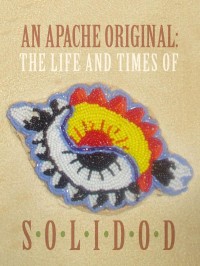
Introduction
When I first met Solidod she was living alone in a tiny room in a rather depressing subsidized-income apartment complex in Florida. She herself was anything but depressing, though. A few minutes after we met she showed me the little knife she carries with her in her buckskin purse. “But Solidod,” I said, “that’s kind of a dangerous knife, isn’t it?” I said- meaning, dangerous for an 80-year woman. “Yeah, it’s sharp,” she laughed, “but it would be better if it was rusty. So the cut would get infected in case I stab somebody.”
Wow, tough lady. Tough, but also funny, curious, brimming with energy, and a world-class storyteller. As she told me about the adventures of her life I realized she’s been everywhere and done just about everything: horse-trainer, bodyguard, trans-Atlantic sailor, carpenter, gardener, artist, you name it. And she’s busy. She spends her days zipping around town selling the t-shirts she paints and the jewelry she makes, checking on old friends and chatting up new ones. Most people her age seem to be winding down; Solidod’s just getting started…
Several of Solidod’s paintings grace the book’s pages. The e-book is in Kindle format: Amazon make a free Kindle Reader for nearly every computer, tablet, smartphone, and web browser. More…
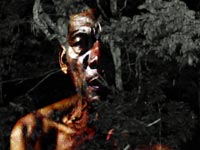
![]() Hearing Voices from NPR®
Hearing Voices from NPR®
141 Ayahuasquereos: Amazon Shamans
Host: Jeremy Narby of Soundwalk Collective
Airs week of: 2012-09-05
“Ayahuasqueros” (52:00 mp3):
An anthropologist’s sound-portrait of the ayahuasca plant and the people of Peru:
In May of 2012, Soundwalk Collective traveled into the heart of the Peruvian Amazon to document the ancient chanting rituals of the Ayahuasquero, the Master Shaman and practitioner of plant medicine. In this ritual, the shaman consumes a potent brew made from the Ayahuasca, a sacred vine of the Amazonian jungle, the “vine of the souls”. The brew induces a powerful psychedelic experience that causes visual and auditory hallucinations.
It is in this state that the Ayahuasquero conjures the “icaro” or magic song.
The icaro is more than song, it is a language through which the shaman communicates with the spirits of plants and animals of the jungle — he speaks through them and they sing through him. There are more than a thousand icaros, through which Ayahuasceros call on the spirits for healing, protection, or attack. Icaros can stun a snake, cure a bite, call the soul back to the body, make a sorcerer fall asleep. Icaros are “pure sound,” melodies abstracted so as to become intangible, to become air. In this intangible and most powerful form icaros allow shamans to swallow darts, visit distant planets, call the rainbow, and kill.
Blowing, rattling leaves and singing are synergistic modes of sound that are, at once verbal, unintelligible and abstract — elevating the song to something transcending language. This piece by Soundwalk Collective documents the ancient practice by inhabiting the Ayahuasquero’s soundscape where the icaros become a visceral, haunting, and consuming listening experience.
“Ayahuasqueros” is a radio essay by anthropologist Jeremy Narby, in collaboration with Francisco Lopez, featuring Victor Nieto and Ushamano Walter Martinez. It was ommissioned by Radio France Culture, mixed by Dug Winningham, and produced by Soundwalk Collective: an international sound-art collective, winner of several Audies for their soundwalks and a Dalton Pen award for the Ground Zero w/ Paul Auster. Since 2000 they “have been sonic nomads, embarking on journeys from the desolate land of Bessarabia to the desert of Rub al Khali. By exploring and documenting the world around them through its sounds, the Collective abstracts and re-composes narrative sound pieces through fragments of reality to form distinct audible journeys.”
AYAHUASQUEROS (Preview) from Soundwalk Collective on Vimeo.
Film by Stephan Crasneanscki
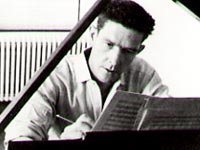
![]() Hearing Voices from NPR®
Hearing Voices from NPR®
140 John Cage: September 5 1912 – August 12 1992
Host: Barrett Golding of Hearing Voices
Airs week of: 2012-08-29
“John Cage” (52:00 mp3):
A tribute to the composer on his 100th birthday:
From a half-hour radio play, commissioned by CBS, written by poet Kenneth Patchen and scored by Cage. Broadcast May 31, 1942 on WBBM radio station (Columbia Broadcasting System in Chicago), as part of their Columbia Workshop series. Performance by Xenia Cage, Cilia Amidon, Stuart Lloyd, Ruth Hartman, Claire Oppenheim and John Cage conducting.
A voxpop variety of folk answer the musical question: “Who’s John Cage?”
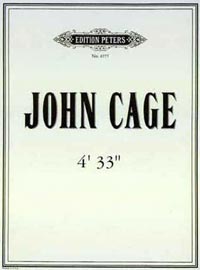
Few contemporary composers had the influence of John Cage. From experimental music to minimalism, Brian Eno to George Winston, echoes of John Cage continue to resound to this day, more than 6 decades after his “Sonatas and Interludes for Prepared Piano” were first published. John Cage was a conceptualist of sound who turned even silence into music as he did with his famous piece, 4 minutes and 33 seconds. John cage died from a stroke in August of 1992. But we hear his thoughts in sound from a 1987 interview. From the series Echoes with John Diliberto, part of their Thoughts in Sound specials.
Pianist Stephen Drury performs a 1948 Cage composition; the title track of the album In a Landscape
From the collection A Chance Operation: The John Cage Tribute (this UbuWeb link has free downloads of the entire CD set).
An impressionistic illustration of synchronistic artistic cooperation, in the words of Cage and choreographer Merce Cunningham. Interviews by Katie Davis, from Jay Allison’s series Living in the Arts.

![]() Hearing Voices from NPR®
Hearing Voices from NPR®
139 Sports Report: Athletic Endeavor
Host: Barrett Golding of Hearing Voices
Airs week of: 2012-08-22
“Sports Report” (52:00 mp3):
The producer’s wife likes to swim at night, far out into the lake. She was taught long ago how to effortlessly, and beautifully, skim across the water. Aired originally on This American Life “Lessons“.
Mashup master GHP, aka, Mark Vidler, mixes Queen’s sports stadium classic, “We Will Rock You,” with AC/DC, Led Zeppelin, Crowded House and a bit of Beatles, Outkast, and Snoop Dogg. Download off GHP’s This Was Pop 2002-2007.
The U.S.A Track and Field Hall of Fame commissioned sound-artist Ben Rubin, of EAR Studio, to make audio art from interviews with athletes.
A gay man gets to know the game. Edited from Mark’s essay, Football & the Homosexual Brain.
The producer spent the winter coaching a boys basketball team in her Washington, DC neighborhood. The boys’ grades aren’t good enough to play for the school, so they join a local church league. And Katie Davis starts more as counselor than coach. Originally aired on NPR. Part of the producers Neighborhood Stories series.
From the soundtrack to Spike Lee’s film, off the album Power To The People And The Beats – Public Enemy’s Greatest Hits [Explicit] (also: clean version
). Features Voices Of Shabach Community Choir Of Long Island, Stephan Stills and samples from his Buffalo Springfield song, “For What it’s Worth
.”
Spin class gets personal, with Chet Siegel as Sam, Emily Tarver as Lisa, Ed Herbstman as Kirk. Written collaboratively by The Truth, from a story by Chet Siegel. Special thanks: Peter Clowney, Kerrie Hillman, and Chris Bannon. Recorded at WNYC and on location in New York City. The Truth podcast is produced by Jonathan Mitchell (also on PRX.
Been retrospecting of late about the pool of production talent who’ve made radio waves for Hearing Voices and the Hearing Voices from NPR series — a damn impressive list of audio luminaries:

Ben Adair
Noah Adams
Owen Agnew
Mark Allen
Jay Allison
quiet american
American Radio Works
Claus Andreasson
Antenna Theater
damali ayo
Mark Baldwin
Jennifer Ball
Alix Blair
Peter Bochan
Jesse Boggs
Tim Bonham
Chris Booker
Alex Caldiero
Scott Carrier
Alex Chadwick
Jack Chance
Andrei Codrescu
Lizzy Cooper Davis
Crossing the BLVD
Curie Youth Radio
Max Darham
Katie Davis
Carmen Delzell
Beverly Donofrio
Amy Dorn
Jesse Dukes
Neenah Ellis
Rebecca Flowers
Hillary Frank
Joe Frank
Grant Fuller
Barrett Golding
David Greenberger
Erica Heilman
Ann Heppermann
Jeremy Hobson
Homelands
Paul Ingles
Kitchen Sisters
Krandall Kraus
Lindsey Lee
Sydney Lewis
Long Haul Productions
Tom Lopez
Taylor Mali
Larry Massett
Kelly McEvers
Gregg McVicar
Devorah Medwin
Todd Melby
Jonathan Menjivar
Viki Merrick
Chelsea Merz
Jeff Metcalf
Ginger Miles
Erin Mishkin
Jonathan Mitchell
Rick Moody
Ceil Muller
Jennifer Nathan
Lynne Neary
Kara Oehler
Curt Olson
David Ossman
Joe Plotts
Radio Diaries
Sandra Rattley
Jeff Rice
John Rieger
Dmae Roberts
Skye Rohde
Steve Rowland
Brent Runyon
SALT Institute
Chase Sbicca
Claire Schoen
Abner Serd
Art Silverman
Sound Portraits
Susan Stamberg
Susan Stone
Matthew Swenson
Sandy Tolan
Andrew Turpening
Nancy Updike
Marjorie Van Halteren
Sarah Vowell
Ben Walker
Jake Warga
Jon Watanabe
Myke Weiskopf
Gregory Whitehead
Eric Winick
Helen Woodward
Youth Radio
Ben Adair
Noah Adams
Owen Agnew
Hammad Ahmed
Mark Allen
Terry Allen
Adam Allington
Ginna Allison
Jay Allison
American Radio Works
Claes Andreasson
Antenna Theater
Jeff Arntsen
Jenny Asarnow
Jess Atkins
damali ayo
Mark Baldwin
Lynda Barry
Jill Battson
Bauersfeld-Erik
Ayala Ben-Yehuda
Michael Bernstein
Phillip Kent Bimstein
Alix Blair
Alex Blumberg
Bob & Ray
Peter Bochan
Jesse Boggs
Tim Bonham
Christopher Booker
Emily Botein
Charles Bowden
Samantha Broun
William S Burroughs
Meryn Cadell
Jason Cady
Alex Caldiero
Julián Cardona
Scott Carrier
Alex Chadwick
Carolyn Jensen Chadwick
Jack Chance
Chicago Matters
Clothesline Revival
Andrei Codrescu
Samuel Cohon
Todd Colby
Sean Cole
Lizzy Cooper Davis
Crossing the BLVD
Curie Youth Radio
Max Darham
Josh Darsa
Kate Davidson
Katie Davis
Carmen Delzell
Amy Dickinson
Beverly Donofrio
Jesse Dukes
EarSay
Earwax
Natelie Edwards
Dave Eggers
Neenah Ellis
Lawrence Ferlinghetti
Firesign Theatre
Steve Fisk
Rebecca Flowers
Hillary Frank
Joe Frank
Grant Fuller
Lou Giansante
Ira Glass
Go Home Productions
Barrett Golding
Douglas Grant
David Greenberger
Guillermo Gómez-Peña
Rich Halten
Trent Harris
Erica Heilman
Ann Heppermann
Homelands
Paul Ingles
Jelani
Chana Joffe-Walt
Calvin Johnson
Joyride Media
Nina Katchadourian
Wednesday Kennedy
Jack Kerouac
Paul Kiernan
Queena Kim
Kitchen Sisters
Kevin Kling
Charles Lane
Lazyboy
Lemon Jelly
Sydney Lewis
Matt Lieber
Long Haul Productions
Tom Lopez
Alan Lorber
Baz Luhrman
Ise Lyfe
Gwen Macsai
Marcos Martinez
Larry Massett
Gregg McVicar
Todd Melby
Jonathan Menjivar
Viki Merrick
Jeff Metcalf
Lisa Miller
Vige Millington
Erin Mishkin
Jonathan Mitchell
Rick Moody
Tracie Morris
Ceil Muller
Musicians Own Words
Jennifer Nathan
Neary Lynn
Mark Neumann
Qui Duc Nguyen
Ken Nordine
Kara Oehler
Curt Olson
David Ossman
Outer Voices
Richard Paul
Pogo
quiet american
Radio Diaries
Radio Rookies
Radiolab
Rathe. Steve
Jason Rayles
Sarah Reynolds
Jeff Rice
Jonathan Richman
John Ridley
John Rieger
Dmae Roberts
Jesikah Maria Ross
Ben Rubin
Brent Runyan
rx
SALT
Sonia Sanchez
Chase Sbicca
Robert Schaefer
Claire Schoen
David Schulman
Tony Schwartz
Shea Shackelford
Harry Shearer
Jean Shepherd
Art Silverman
Joe Skyward
Judith Sloan
Sound Portraits
Susan Stamberg
Susan Stone
StoryCorps
Ian Svenonius
Matthew Swenson
Catie Talarski
Rocky Tayeh
Taylor Mali
The Professor
This American Life
This I Believe
Sandy Tolan
Transom
Andrew Turpening
UbuWeb
Nancy Updike
Luis Alberto Urrea
Nick van der Kolk
Marjorie Van Halteren
Willie Vlautin
Sarah Vowell
Benjamen Walker
Jake Warga
Chris Watson
David Weinberg
Myke Weiskopf
Western Folklife Ctr
John Widoff
Flawn Williams
Eric Winick
Youth Radio
M’lou Zahner
ZBS
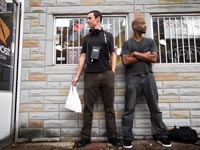
![]() Hearing Voices from NPR®
Hearing Voices from NPR®
138 Out of the Blocks: One City Block, Everybody’s Story
Host: Aaron Henkin of WYPR-Baltimore
Airs week of: 2012-07-04
“Out of the Blocks” (52:00 mp3):
One hour of radio, one Baltimore city block, everybody’s story:
What does a city block sound like? Aaron Henkin of WYPR-Baltimore and electronic/hip hop musician Wendel Patrick hit the sidewalk, spending several months documenting the stories, voices, and people who populate the 3300 block of Greenmount Avenue, in Baltimore. We go inside the hair salon, the tattoo parlor, and the check cashing business. We talk to a street preacher and homeless street people. This is a community of different nationalities, ethnicities, and religions; in other words: an All American block.
Both producers are Baltimore-based. Aaron Henkin produced the program for the WYPR series he works on, The Signal. This HV hour also features music from co-producer Wendel Patrick’s 2011 album Forthcoming. His 2007 collection is called Sound:.
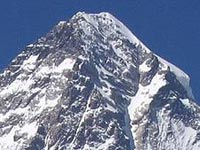
![]() Hearing Voices from NPR®
Hearing Voices from NPR®
137 In the Mountains: Towards the Summit
Host: Barrett Golding of Hearing Voices
Airs week of: 2012-06-20
“In the Mountains” (52:00 mp3):
Heading towards the summit:
Field recordings in the Annapurna region of Nepal near Tibet, including a ceremony for the Buddha’s birthday, a few donkey trains passing in a cacophony of melodious bells; and a five-foot prayer wheel in a Buddhist gompa in Marpha.
From NPR Radio Expeditions, hidden deep in the woods of the Payette National Forest are the terraced remnants of the “Ah Toy Garden” (near the town of Warren, Idaho), now on the National Register of Historic Places. Produced by Carolyn Jensen Chadwick with sound desgin by Michael Scweppe.
When most people are headed to the beach, our producer heads for the ski slopes near his home in Utah. The goal is to find a combination of freezing and thawing in the late spring that gives the mountain snow pack the singular spring skiing experience(on PRX | on NPR).
Attempting to climb the world’s most deadly and second highest demands extreme gear, training, timing, preparation, and a carefully selected team. Joe Frank eschews every bit of that: why make so easy? Excepted from Joe’s hour, Mountain Rain, available on CD and as an MP3. Music: “Buried At Sea” MC 900 Ft Jesus, One Step Ahead of the Spider.
K2 photo courtesy: Kevin Mayea
 HV editor Larry Massett helped our friend Solidad publish her new e-book, An Apache Original: The Life and Times of Solidod
HV editor Larry Massett helped our friend Solidad publish her new e-book, An Apache Original: The Life and Times of Solidod. Solidod is in her 80s and has about 300 years of her life stories to tell. Here’s an excerpt from Larry’s…
Introduction
When I first met Solidod she was living alone in a tiny room in a rather depressing subsidized-income apartment complex in Florida. She herself was anything but depressing, though. A few minutes after we met she showed me the little knife she carries with her in her buckskin purse. “But Solidod,” I said, “that’s kind of a dangerous knife, isn’t it?” I said- meaning, dangerous for an 80-year woman. “Yeah, it’s sharp,” she laughed, “but it would be better if it was rusty. So the cut would get infected in case I stab somebody.”
Wow, tough lady. Tough, but also funny, curious, brimming with energy, and a world-class storyteller. As she told me about the adventures of her life I realized she’s been everywhere and done just about everything: horse-trainer, bodyguard, trans-Atlantic sailor, carpenter, gardener, artist, you name it. And she’s busy. She spends her days zipping around town selling the t-shirts she paints and the jewelry she makes, checking on old friends and chatting up new ones. Most people her age seem to be winding down; Solidod’s just getting started…
Several of Solidod’s paintings grace the book’s pages. The e-book is in Kindle format: Amazon make a free Kindle Reader for nearly every computer, tablet, smartphone, and web browser.
Here’s a few paragraphs from chapter one: More…

![]() Hearing Voices from NPR®
Hearing Voices from NPR®
136 Where Wild Things Are: Maurice Sendak Memorial
Host: Barrett Golding of Hearing Voices
Airs week of: 2012-05-30
“Where Wild Things Are” (52:00 mp3):
A memorial to recently departed cultural innovators: Beastie Boys bassist and rapper Adam Yauch — aka, “MCA,” British hairdresser and business person Vidal Sassoon, pioneer FM rock n’ roll disc jockey (WOR-FM, WNEW, WFUV, XM satellite radio) Pete Fornatale, and mostly we hear mostly we hear children’s literature author/illustrator Maurice Sendak, along with all the music and movies inspired by his 1963 classic, “Where the Wild Things Are.”
The Wild Mix (playlist below) was produced by Peter Bochan, General Manager of WPKN-Bridgeport CT, announcer WBAI-NYC NY, and mixmaster at All Mixed Up Productions. His Shortcuts and other mixes are at PRX.
We also hear music from the ballet, “Where the Wild Things Are,” by composer Randall Woolf, created with Maurice Sendak and Septime Webre for the American Repertory Ballet.

![]() Hearing Voices from NPR®
Hearing Voices from NPR®
135 Shades of Gray: Life & Choice
Host: Ahri Golden of Thin Air Media
Airs week of: 2012-04-11
“Shades of Gray” (52:00 mp3):
An audio mosaic about abortion in America:
Pro-choice. Pro-life. Most people have already chosen sides in the ongoing debate, so why revisit the issue? Shades of Gray shares a range of stories told by people young and old who have been directly affected by abortion, instead of the polemics of irreconcilable extremes. It’s a carefully crafted audio mosaic and a stark portrayal of the intensely personal nature of our relationship with abortion. This is the fair and frank discussion America rarely has but desperately needs.
Winner of the 2004 Golden Reel for National Documentary. A longer version is at PRX. Produced and original music score by Jonathan Mitchell of The Truth. Co-produced and narrated by Ahri Golden of Thin Air Media.

![]() Hearing Voices from NPR®
Hearing Voices from NPR®
134 Close to Death: At Life’s End
Host: Barrett Golding of Hearing Voices
Airs week of: 2012-03-21
“Close to Death” (52:00 mp3):
People near the process of death and dying:
It takes four seconds to hit the water from the Golden Gate Bridge. A year ago the producer’s friend Phil took that fatal jump. They met several years before that when Phil’s brother committed suicide (transcript).
Herman Porter, a blind man, slipped unseen beneath a moving subway train: 90 tons of steel and electricity. (Hear Alex Chadwick’s eulogize for NPR’s pioneering producer: “Josh Darsa Obituary“.)
Writer Carmen Delzell visit her grandmother, who broke her hip — not uncommon, says the doctor, for an 89-year-old.
Scott Carrier talks to the family, the ex-husband, the mortuary, the doctors, even the grave digger, in piecing together the memory of a life. Prodcued for New American Radio. (Scott’s most recent book is Prisoner of Zion.)
Messages on my the producer’s mother’s tape machine, found after his father’s death; original music by Skyward. This Kaddish is a mourner’s prayer.
Ibn Thabit feat. Salah Ghaly, “Our Martyrs:”

![]() Hearing Voices from NPR®
Hearing Voices from NPR®
133 Destination Unknown: Getting Nowhere, Slow
Host: Barrett Golding of Hearing Voices
Airs week of: 2012-03-07
“Destination Unknown” (52:00 mp3):
Are We There Yet?:
Zeno’s paradox hits the highway, asking How Can You Be In Two Places At Once When You’re Not Anywhere At All?.
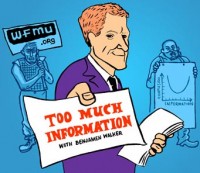 “Remedial Theory” (2004 /13:30) Benjamen Walker
“Remedial Theory” (2004 /13:30) Benjamen WalkerGreat novels induce empathy for others’ experiences. So how is it a man now on trial for crimes against humanity is an avid fiction reader of fiction? Might he simply be reading the wrong books? We take a trip to The Hague to hand-deliver the ‘right’ books to Slobodan Milosevic. Produced with Michael Kavanagh of The Next Big Thing and HV’s Larry Massett. Ben Walker hosts WFMU’s Too Much Information, where “the sober hangover after the digital party has run out of memes, apps and schemes” (TMI playlists / archives). He also produces The Big Ideas podcast for The Guardian.
“Where you boys going? The swamp… you’re not from around here, are you?” Off Dust My Broom.
Scott’s first radio piece: he and his microphone hitch from his home in Salt Lake City to the doorstep of NPR, recording the people he meets along the way (mixed by NPR’s Dawn Warneke). Scott’s most recent book is Prisoner of Zion.)
Donna, a supermarket checkout clerk, dreams of faraway places, in the ZBS radio soap, Saratoga Springs.
Form the collaboration called Wide Open Spaces . Internet Archive has the entire performance: “People Like Us, Matmos and Wobbly Live at San Francisco Art Institute on 2002-10-05.”
Wobbly, People Like Us and Matmos circled their wagons in the lecture hall of the San Francisco Art Institute. Having mutually agreed upon a country-and-western theme, Vicki Bennett (PLU), Jon Leidecker (Wobbly), and Drew Daniel and M. C. Schmidt (Matmos) pored over their archives of honky-tonk classics, chopping and dicing Nashville’s finest almost beyond recognition, and collectively re-stitched the mangled shreds in crazed digital quilting bee.
“Changed Priorities” sign photo (cc) courtesy Christine.
Damn this guy’s good, another Pogo creation:
This is my remix of an original song by SaraSinger42:Â youtube.com/SaraSinger42
The video was shot by Sara’s mother, singer and song writer Jackie Messenger: youtube.com/JackieMessenger. Sara is part of a beautiful family who have always been wonderfully supportive of me.
This track came about almost immediately when I found Sara’s channel. I wondered what her song would sound like with a beat, so I spent around 10 minutes knocking together a drum sequence before layering in her song. 45 minutes later, I seem to have spontaneously put together a complete track.
—Pogo
Read all about it: Eleven (SaraSinger42 Remix) on Vimeo.
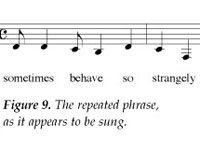
![]() Hearing Voices from NPR®
Hearing Voices from NPR®
132 Musicality of Speech: Spoken Melody
Host: Barrett Golding of Hearing Voices
Airs week of: 2012-02-15
This program contains copyrighted material not licensed for web-streaming, so we cannot offer an mp3 of this week’s episode.
A history of what composer Steve Reich calls speech-melodies:
“It’s Gonna Rain” was composed in San Francisco in January 1965. The voice belongs to a young black Pentecostal preacher who called himself Brother Walter. I recorded him along with the pigeons and traffic one Sunday afternoon in Union Square in downtown San Francisco. Later at home I started playing with tape loops of his voice and, by accident, discovered the process of letting two identical loops go gradually out of phase with each other.
In the first part of the piece the two loops are lined up in unison, gradually move completely out of phase with each other, and then slowly move back to unison. In the second part two much longer loops gradually begin to go out of phase with each other. This two-voice relationship is then doubled to four with two voices going out of phase with the other two. Finally the process moves to eight voices and the effect is a kind of controlled chaos, which may be appropriate to the subject matter – the end of the world.
“It’s Gonna Rain” is the first piece ever to use the process of gradually shifting phase relations between two or more identical repeating patterns. The second was “Come Out.” Composed in 1966, it was originally part of a benefit presented at Town Hall in New York City for the retrial, with lawyers of their own choosing, of the six boys arrested for murder during the Harlem riots of 1964. The voice is that of Daniel Hamm, now acquitted and then 19, describing a beating he took in Harlem’s 28th precinct station. The police were about to take the boys out to be “cleaned up” and were only taking those that were visibly bleeding. Since Hamm had no actual open bleeding he proceeded to squeeze open a bruise on his leg so that he would be taken to the hospital.
“I had to like open the bruise up and let some of the bruise blood come out to show them.” More…
Walking, maps, and art — some of my favorite stuff — are all wrapped up in one project, “a transect – Due East:”
A body of work based on a series of cross-country hikes that enabled me to generate visual and written notation, correspondence, interviews and historic research. The location is specific to my homeland in the San Joaquin Valley of California where I traveled due east into the foothills and Sierra Nevada Mountains.
–Matthew Rangel, Project Statement
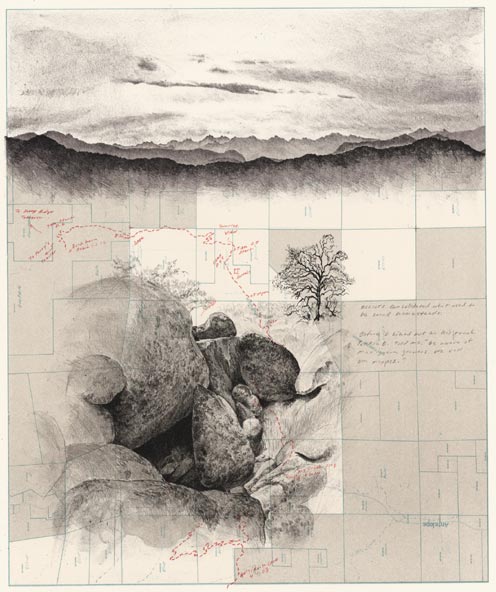 Due East through Elliot Ranch, 2008,
Due East through Elliot Ranch, 2008,
lithograph, 22″ x 28.5″, by Matthew Rangel
A PDF of the collection is at the artist’s site: “a transect – Due East.”